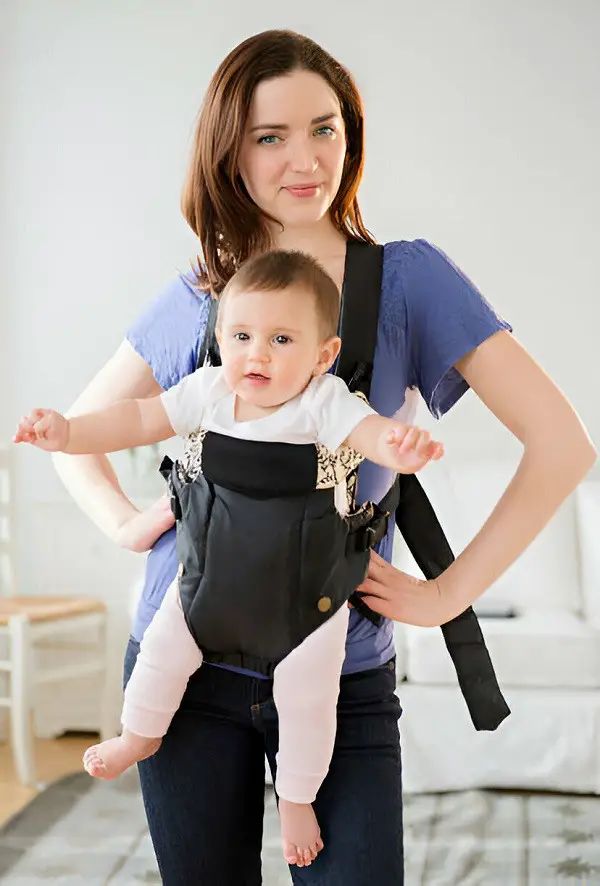Last Updated on January 6, 2025
Navigate the world with your baby right next to your heart with our comprehensive, step-by-step guide on how to safely use a newborn baby carrier. This guide ensures a secure and comfortable experience for you and your newborn, every step of the way.
Importance of Safe Baby Carrying
With your baby nestled in a carrier, you may venture out into the world, having your hands free while still being able to respond to your newborn’s needs. But with the numerous options available in the market, it can be a daunting task to use a newborn baby carrier safely. In essence, using a baby carrier safely means ensuring the comfort and safety of both the wearer and the baby.

Choosing the Right Newborn Baby Carrier
Before you can start strapping your baby into a carrier, it’s essential to choose the right carrier. While one style of baby carrier might work wonders for a friend, it might not be the best fit for you and your baby. From fabric slings and soft structured carriers to the more traditional wraps, every type of carrier has its unique advantages and learning curve.
When choosing a carrier, consider factors such as your baby’s age and weight, your physical comfort, and the situations in which you’ll be using the carrier. It might be worthwhile to test different types of carriers before making a final decision.
Explore the complete guide on baby carriers for newborns at BecomingMamas.com. Tiana has an awesome article to help you find the best carrier to keep your newborn close, comfortable, and safe.
Getting Ready: Pre-use Safety Checks
Before placing your baby into the carrier, conduct a quick check for any signs of wear and tear. Look for frayed fabrics, loose stitching, or damaged buckles. Check that all straps and adjustments are working correctly. The carrier should be clean and in good condition before each use.
Step 1: Preparing Your Carrier
Place the carrier on a clean, flat surface and unfold it completely. Ensure all straps and buckles are untangled and easily accessible. For wraps or slings, spread them out to inspect for any twists or knots in the fabric.
Step 2: Positioning Your Newborn in the Carrier
Carefully place your baby in the carrier, ensuring that they are seated deeply in the carrier with a rounded back. The baby’s legs should be in an M-position, which is the natural and recommended position for a baby’s development: knees higher than the buttocks and the thighs supported.
Step 3: Adjusting and Securing the Straps
Once your baby is positioned correctly, adjust the carrier’s straps to secure them. Pull the straps snug, but not too tight – you should be able to fit two fingers between your baby and the strap.
Step 4: Ensuring Correct Posture and Alignment
Your baby’s spine should be in a natural, curved position, and its head should be close enough for you to kiss. The carrier should support your baby from knee to knee, with their legs in a frog-like position.
Step 5: Regular Checks and Adjustments
Regularly check the baby’s position, and ensure they are comfortable and secure. Adjust the carrier as your baby grows and gains weight to maintain optimal support.
Common Mistakes to Avoid
To ensure the utmost safety and comfort for your baby, avoid these common mistakes:
Avoiding Overheating
Be mindful of your baby’s body temperature. Avoid overdressing them or covering their face excessively.
Not Checking Carrier Instructions
Always read and follow the carrier’s instructions to ensure proper use.
Avoiding Unsafe Activities
Do not engage in activities that may be dangerous or risky while using the carrier.
Benefits of Using a Newborn Baby Carrier
Using a newborn baby carrier offers numerous benefits:
Bonding with Your Baby
Carrying your baby close fosters a strong emotional bond between you and your little one.
Hands-Free Convenience
With a baby carrier, you have both hands free for other tasks while keeping your baby close.
Calming Effects for Baby
Being close to the caregiver in a carrier can have a soothing and calming effect on babies.
Enhanced Breastfeeding Experience
A carrier can make breastfeeding on-the-go more comfortable and discreet.
FAQs
1. Can I use a baby carrier for a premature baby?
It is essential to consult your pediatrician before using a baby carrier for a premature baby. Premature babies may have specific needs, and professional advice will ensure their safety and well-being.
2. How long can I carry my newborn in a baby carrier each day?
Newborns can be carried in a baby carrier for several hours each day, but it’s essential to listen to your baby’s cues. If they become fussy or uncomfortable, take them out and provide a break.
3. Are there any age or weight restrictions for using baby carriers?
Most baby carriers have weight and age recommendations provided by the manufacturer. Follow these guidelines to ensure the carrier’s safe use.
4. Can dads use baby carriers too?
Absolutely! Baby carriers are designed for both moms and dads to use comfortably, fostering bonding and caregiving.
5. Are baby carriers safe for my back and posture?
Using a properly adjusted baby carrier with the right fit can be comfortable and safe for your back and posture. However, if you experience discomfort, consider using different carrying positions or consulting a babywearing expert.
Conclusion
Using a newborn baby carrier is a wonderful way to nurture your baby’s well-being while still maintaining your daily routine. By following the step-by-step guide and avoiding common mistakes, you can ensure a safe and enjoyable experience for both you and your little one. Embrace the bond that comes from carrying your baby close in a carrier, and enjoy the precious moments together.








